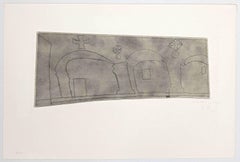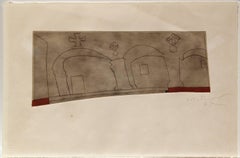Items Similar to May 60 (Duomo Pisa), Watercolour Painting by Ben Nicholson, 1960
Want more images or videos?
Request additional images or videos from the seller
1 of 6
Ben NicholsonMay 60 (Duomo Pisa), Watercolour Painting by Ben Nicholson, 19601960
1960
Price Upon Request
Price Upon Request
Price Upon Request
Price Upon Request
Price Upon Request
Price Upon Request
Price Upon Request
Price Upon Request
Price Upon Request
Price Upon Request
Shipping
Retrieving quote...The 1stDibs Promise:
Authenticity Guarantee,
Money-Back Guarantee,
24-Hour Cancellation
About the Item
May 60 (Duomo Pisa), Watercolour Painting by Ben Nicholson 1894-1982, 1960
Additional information:
Medium: Watercolour and pencil on paper, mounted on the Artist's board
46.2 x 60.4 cm
18 1/4 x 23 3/4 in
Titled and dated; signed and inscribed verso
The thoughtful lines of Ben Nicholson’s pencil imply the geometric precision of architectural elevations. He positions the viewer on an upper loggia of the campanile and overlooking the transept of the Duomo, reducing the architectural design to line and form in a stylistic obverse to his Cubist flattening of the landscape. Such antithetical practice seems a playful exploration of the campanile’s colloquial name ‘the leaning tower of Pisa’, veritably toppled by Nicholson.
Following Nicholson’s early commitment to Constructivist principles, advocating mathematical precision, clean lines and an absence of ornament, this work comes at a time of enhanced creativity. Having moved to the Swiss Alps in 1958 with his third wife Felicitas Vogler, Nicholson entered a proliferate period inspired by his relocation to the heart of the continent. He was not only removed from the sometimes fractious internal politics of the British art world and the rivalries between its peers, but was also able to travel more extensively, and the subsequent works from this period are a catalogue of his travels.
Of his travels he concluded that 'I have favourite places - Mycenae and Pisa, and Siena, for instance - and I feel that in a previous life I must have laid two or three of the stones in Siena Cathedral...' (Ben Nicholson, Sunday Times, 28th April 1963)
Provenance
Galleria Gian Ferrari, Milan;
Private Collection, UK;
Bonhams Nov 2015;
Private Collection, UK.
Ben Nicholson was a key twentieth-century British artist and early proponent of Modernism.
Nicholson was born in Denham, Buckinghamshire, and was the son of the artists William Nicholson and Mabel Pryde. He studied at the Slade School of Art, 1910-11. He spent 1912 to 1914 in France and Italy, and was in the United States in 1917-18. He married the artist Winifred Roberts in 1920. Over the next three years they spent winters in Lugano, Switzerland, then divided their time between London and Cumberland.
In 1931, Nicholson's relationship with the sculptor Barbara Hepworth resulted in the breakdown of his marriage to Winifred. He and Hepworth married in 1938 and divorced in 1951. Nicholson lived in London from 1932 to 1939, making several trips to Paris in 1932-3, visiting the studios of Picasso, Braque, Arp, Brancusi and Mondrian. From 1939 to 1958 he lived and worked in Cornwall, before moving to Switzerland. He returned to London in 1974.
Nicholson's earliest paintings were still lifes influenced by those of his father. In the 1920s he began painting figurative and abstract works inspired by Post Impressionism and Cubism. He produced his first geometric and abstract reliefs in 1933. He first exhibited in 1919, at the Grosvenor Gallery and Grafton Galleries. His first one-man show was held at the Twenty-one Gallery, London in 1924. From 1924 to 1935 he was a member of the Seven and Five Society, exhibiting alongside Henry Moore, John Piper, Cedric Morris, Winifred, Christopher Wood, Hepworth and David Jones. In 1933 he joined Unit One, founded by Paul Nash. In 1937 Nicholson, Naum Gabo and the architect Leslie Martin edited Circle: International Survey of Constructive Art. Circle identified Nicholson with a group of like-minded artists and architects who wanted to apply 'constructivist' principles to public and private art, advocating mathematical precision, clean lines and an absence of ornament.
In 1952 Nicholson won first prize at the Carnegie International, Pittsburgh. He was awarded the first Guggenheim International painting prize in 1956, and the international prize for painting at the Sao Paulo Bienal in 1957. He received the Order of Merit in 1968. Numerous retrospective exhibitions of his work have been held, including shows at the Venice Biennale and Tate Gallery in 1954-5, Kunsthalle, Berne in 1961, Museum of Fine Arts, Dallas in 1964, Albright-Knox Art Gallery, Buffalo in 1978, and Tate Gallery in 1993-4. Helped by wide international exposure in British Council tours during the 1940s and 1950s and by the championing of the writer Herbert Read, Nicholson's work came to be seen, with Henry Moore's, as the quintessence of British modernism. His work is many public and private collections, including the Courtauld, London; and Yale Center for British Art. Many books have been published on Nicholson, including a 2019 monograph from Lund Humphries.
- Creator:Ben Nicholson (1894 - 1982, British)
- Creation Year:1960
- Dimensions:Height: 18.25 in (46.36 cm)Width: 23.75 in (60.33 cm)
- Medium:
- Period:
- Condition:
- Gallery Location:Kingsclere, GB
- Reference Number:1stDibs: LU2718214575572
Ben Nicholson
Ben Nicholson, one of Britain’s most influential modernist painters, was the son of renowned artist William Nicholson. His early career was shaped by extensive travels during the 1920s with his first wife, Winifred Roberts, living between Cumberland, London, Paris, and Switzerland. Initially experimenting with a post-Cézanne style, Nicholson later embraced a more consciously "primitive" approach to landscape painting in 1927, influenced by his encounter with the work of Alfred Wallis. Between 1931 and 1939, while living in London, Nicholson became closely associated with leading artists and critics such as Henry Moore, John Piper, Naum Gabo, and Herbert Read. Encounters with European modernists, including Hans Arp, Constantin Brâncuși, Piet Mondrian, and Jean Hélion, profoundly shaped his artistic direction. By the late 1930s, he had developed the highly abstract style for which he is best known.
In 1931, Nicholson met sculptor Barbara Hepworth, who would become his second wife. During World War II, they relocated to St Ives with Gabo and Adrian Stokes, contributing to the town’s emergence as a centre for modernist art. By the 1950s and 1960s, Nicholson had gained an international reputation, his work celebrated for its purity of form and pioneering abstraction.
Following the war, he lived in London, Cambridge, and Switzerland at various times. In later years, he married for a third time, to photographer Felicitas Vogler, continuing to refine his artistic vision until his death in 1982.
About the Seller
No Reviews Yet
Vetted Professional Seller
Every seller passes strict standards for authenticity and reliability
Established in 2010
1stDibs seller since 2024
40 sales on 1stDibs
Typical response time: 14 hours
- ShippingRetrieving quote...Shipping from: Kingsclere, United Kingdom
- Return Policy
Authenticity Guarantee
In the unlikely event there’s an issue with an item’s authenticity, contact us within 1 year for a full refund. DetailsMoney-Back Guarantee
If your item is not as described, is damaged in transit, or does not arrive, contact us within 7 days for a full refund. Details24-Hour Cancellation
You have a 24-hour grace period in which to reconsider your purchase, with no questions asked.Vetted Professional Sellers
Our world-class sellers must adhere to strict standards for service and quality, maintaining the integrity of our listings.Price-Match Guarantee
If you find that a seller listed the same item for a lower price elsewhere, we’ll match it.Trusted Global Delivery
Our best-in-class carrier network provides specialized shipping options worldwide, including custom delivery.More From This Seller
View AllUntitled (Stack), Gouache and Pencil Painting by Prunella Clough, 1975 circa
By Prunella Clough
Located in Kingsclere, GB
Untitled (Stack), Gouache and Pencil Painting by Prunella Clough, 1975 circa
Additional information:
Medium: Gouache and pencil
21.6 x 18.2 cm
8 1/2 x 7 1/8 in
Prunella Clough was ...
Category
20th Century Abstract Paintings
Materials
Pencil, Gouache
Italian Scene, Pen and Ink with Wash Painting by Reginald Brill, 1950s circa
By Reginald Brill
Located in Kingsclere, GB
Italian Scene, Pen and Ink with Wash Painting by Reginald Brill, 1950s circa
Additional information:
Medium: Pen and ink with wash
33 x 48.3 cm
13 x 19 in
Reginald " Reggie" Brill was a versastile 20th century artist and teacher.
Brill was born in London in 1902 and spent his early childhood there and in Yorkshire. By the time of the First World War, at the age of 13, he was living in lodgings in London, working in a City office and attending St Martins School of Art in the evenings. Considering his lack of education, winning a scholarship to The Slade (now part of University College London) in 1921 where he studied under Henry Tonks for three years, was a huge achievement.
On leaving The Slade he found patronage in Lincolnshire, but by the time of the General Strike (1926) he had returned to London and was working on Lansbury's Labour Weekly. He married Rosalie, also an artist, and in 1927 won the Prix de Rome in Decorative Painting. Following two years at The British School in Rome, Brill went to teach at Blackheath School of Art. During 1930 he spent three months painting in Egypt and it was there that he met Col. T G Gayer-Anderson, one of the twin brothers who were to bequeath The Little Hall in Lavenham as a hostel for art students. It was there that Brill retired to act as warden, thus continuing his nurturing of art students until his death in 1972.
Brill took up his appointment at The School of Art, Kingston upon Thames in January 1934. It was situated in the Technical Institute (Kingston Hall Road) and Brill found it bohemian and disorganised. He proceeded to inject enthusiasm, order and discipline. Within 5 years of his appointment a purpose-built School of Art was opened in Knights Park. It remained open throughout the war and by 1945 there was a waiting list for places. Under the skilled and totally dedicated direction of Brill, Kingston School of Art became established with national reputation for excellence. In 1961 Sir Charles Wheeler opened the new building at Knights Park. Costing £100,000, this more than doubled the size of the Art School.
Brill, was a well-known figure in Kingston. His eloquence made him popular as a guest speaker and his promotion of Art and Design stretched well beyond the doors of Knights Park. Apart from establishing two of the main buildings which makeup what is now known as the Faculty of Design, one of the most visible local contributions he made was the setting up of a topographical collection of paintings depicting Kingston, which has since become known as The Brill Collection at Kingston Museum. Brill gained huge respect and admiration from the hundreds of pupils who studied at Kingston during his 30-year leadership.
He published two books, Modern Painting 1946 and Art as a Career 1962, both bearing a strong educational angle. He regularly exhibited along with leading artists of his era at The Royal Academy, both his paintings and his acutely observed drawings. All the while he was a prolific artist, although reading his diaries, intensely self-critical. His perfectionism, acute powers of observation and relentless research can be seen in his drawings, which via the media and methods he explored throughout his life reflect mid 20th century British Art at its most typical. His major series of work, known as 'The Martyrdom of Man', was carried on in parallel to his career as a teacher. These paintings reflect his care for fellow man and depict people at work, e.g., The Operation, The Jury, Linemen, Waiting Room and Rest, which recently sold at Sotheby’s and was specially restored for The Brill Retrospective. His smaller works also play with the theme of everyday events and communication amongst people, such as The Bull Ring and Market Place paintings.
Brill's name is associated particularly with human figure compositions, but he also worked on landscapes, portraits and details of plants, animals, interiors etc. As one would expect he moved from one media to another, and his unusual hand painted and cut paper mosaics...
Category
20th Century Landscape Paintings
Materials
Pen
Kirby Hall, Northamptonshire, Gouache with Ink and Wash Painting, 1940-42 circa
By John Piper
Located in Kingsclere, GB
Kirby Hall, Northamptonshire, Gouache with Ink and Wash Painting, 1940-42 circa
Additional information:
Medium: Gouache with ink and wash
15.2 x 18.5 cm
6 x 7 1/4 in
As part of an eight-page pamphlet for The Colour of English Country Houses in 1944, Piper included a lovely auto-lithograph of Kirby Hall in Northamptonshire. This work was most likely sketched on the occasion of his visit to the Hall at this time and is of a slightly different angle. It is a working version of the cover of C Aspinall-Oglander's 'Admiral’s Widow’, 1942 (Hogarth Press). The print is cat. no.51.\\\
Piper gives a lovely description of this Elizabethan country house in the introduction to the pamphlet as follows: ‘A yellow stone house of the seventeenth century, in rolling green hunting-country. It gleams in the sun, forms a warm eye-catcher in dull weather and glimmers whitely in moonlight. It is another ruin, partly roofless, and has recently taken over by the Office of Works to be preserved as a show-place.’ (John Piper). Here, Piper, painting at night in the light of the moon, depicts the north front from the inner courtyard, capturing the brilliance of the moonlit night as it dances over the ruins making it in Piper’s own words ‘glimmer whitely’ whilst the dramatic shadows darken the archways and windows.
John Piper was a painter of architecture, landscape and abstract compositions, a designer for the theatre and of stained-glass windows, and a writer on the arts.
Piper was born in 1903 in Epsom, Surrey, the son of a solicitor. Throughout his childhood, he regularly visited Italy, and by 1924 he had published a book of poems and his own illustrations. He worked in his father's office in Westminster until 1928 when he began studying at the Richmond and Kingston Schools of Art. This was followed by two years study at the Royal College of Art. In 1927 he exhibited with David Birch at the Arlington gallery, and in 1931 with Clarice Moffat, P. F. Millard, and his first wife Eileen Holding...
Category
20th Century Abstract Paintings
Materials
Gouache
From the Calcina, September (Venice), by Peter Greenham, 1991
By Peter Greenham
Located in Kingsclere, GB
From the Calcina, September (Venice), Watercolour over Pencil Painting, 1991
Additional information:
Medium: Watercolour over pencil
15.2 x 21.6 cm
6 x 8 1/2 in
Signed, dated and titled on the reverse
Peter Greenham was a distinguished figurative painter of portraits, landscapes and incidents from domestic life. His work was both sensitive and intelligent and like himself, without showiness or pretension. He was keeper of the Royal Academy Schools and a popular figure who taught many well-known artists including Martin Yeoman, Peter Kuhfeld, Edmund Fairfax-Lucy and Jane Corsellis.
Greenham was born in Streatham and educated at Dulwich before studying English at Magdalen College, Oxford, followed by Fine Art at the Byam Shaw School of Art in Kensington from 1936-39 under the supervision of Ernest Jackson.
After leaving Byam Shaw he became a schoolmaster at Magdalen College School, Oxford and was elected an Associate of the Royal Academy in 1951 and an R.A. in 1960.
In 1964 he succeeded Sir Henry Rushbury as Keeper of the Royal Academy Schools, a position he held with distinction until his retirement in 1985. The Keeper has the responsibility of running the RA Schools and Greenham showed himself to have great sympathy and understanding for his students.
In retirement he was able to concentrate entirely on his painting and tended to paint places he knew well such as the Norfolk coast, Northumberland, Oxfordshire and Annecy as well as his wife, the painter Jane Dowling...
Category
20th Century Landscape Drawings and Watercolors
Materials
Watercolor
Italian Landscape, Pen Painting by Reginald Brill, 1950 circa
By Reginald Brill
Located in Kingsclere, GB
Italian Landscape, Pen Painting by Reginald Brill, 1950 circa
Additional information:
Medium: Ink
20 x 34 cm
7 7/8 x 13 3/8 in
Reginald " Reggie" Brill was a versastile 20th century artist and teacher.
Brill was born in London in 1902 and spent his early childhood there and in Yorkshire. By the time of the First World War, at the age of 13, he was living in lodgings in London, working in a City office and attending St Martins School of Art in the evenings. Considering his lack of education, winning a scholarship to The Slade (now part of University College London) in 1921 where he studied under Henry Tonks for three years, was a huge achievement.
On leaving The Slade he found patronage in Lincolnshire, but by the time of the General Strike (1926) he had returned to London and was working on Lansbury's Labour Weekly. He married Rosalie, also an artist, and in 1927 won the Prix de Rome in Decorative Painting. Following two years at The British School in Rome, Brill went to teach at Blackheath School of Art. During 1930 he spent three months painting in Egypt and it was there that he met Col. T G Gayer-Anderson, one of the twin brothers who were to bequeath The Little Hall in Lavenham as a hostel for art students. It was there that Brill retired to act as warden, thus continuing his nurturing of art students until his death in 1972.
Brill took up his appointment at The School of Art, Kingston upon Thames in January 1934. It was situated in the Technical Institute (Kingston Hall Road) and Brill found it bohemian and disorganised. He proceeded to inject enthusiasm, order and discipline. Within 5 years of his appointment a purpose-built School of Art was opened in Knights Park. It remained open throughout the war and by 1945 there was a waiting list for places. Under the skilled and totally dedicated direction of Brill, Kingston School of Art became established with national reputation for excellence. In 1961 Sir Charles Wheeler opened the new building at Knights Park. Costing £100,000, this more than doubled the size of the Art School.
Brill, was a well-known figure in Kingston. His eloquence made him popular as a guest speaker and his promotion of Art and Design stretched well beyond the doors of Knights Park. Apart from establishing two of the main buildings which makeup what is now known as the Faculty of Design, one of the most visible local contributions he made was the setting up of a topographical collection of paintings depicting Kingston, which has since become known as The Brill Collection at Kingston Museum. Brill gained huge respect and admiration from the hundreds of pupils who studied at Kingston during his 30-year leadership.
He published two books, Modern Painting 1946 and Art as a Career 1962, both bearing a strong educational angle. He regularly exhibited along with leading artists of his era at The Royal Academy, both his paintings and his acutely observed drawings. All the while he was a prolific artist, although reading his diaries, intensely self-critical. His perfectionism, acute powers of observation and relentless research can be seen in his drawings, which via the media and methods he explored throughout his life reflect mid 20th century British Art at its most typical. His major series of work, known as 'The Martyrdom of Man', was carried on in parallel to his career as a teacher. These paintings reflect his care for fellow man and depict people at work, e.g., The Operation, The Jury, Linemen, Waiting Room and Rest, which recently sold at Sotheby’s and was specially restored for The Brill Retrospective. His smaller works also play with the theme of everyday events and communication amongst people, such as The Bull Ring and Market Place paintings.
Brill's name is associated particularly with human figure compositions, but he also worked on landscapes, portraits and details of plants, animals, interiors etc. As one would expect he moved from one media to another, and his unusual hand painted and cut paper mosaics...
Category
20th Century Landscape Paintings
Materials
Pen
Squares and Circles, from Twelve Lithographs by Barbara Hepworth, 1969
By Barbara Hepworth
Located in Kingsclere, GB
Squares and Circles, from Twelve Lithographs by Barbara Hepworth, 1969
Additional information:
Medium: lithograph
58 x 80 cm
22 7/8 x 31 1/2 in
signed and numbered in pencil
Barbar...
Category
20th Century Abstract Prints
Materials
Lithograph
You May Also Like
Torcello II - Etching by Ben Nicholson - 1967
By Ben Nicholson
Located in Roma, IT
Torcello II is an original artwork realized by Ben Nicholson in 1967.
Hand signed and dated on the lower right margin. Not numbered.
Black and white etching.
Includes frame: 54.5...
Category
1960s Contemporary Figurative Prints
Materials
Etching
Siena [Large Version] - British Modernism Italian Architecture Siena
By Ben Nicholson
Located in London, GB
This original etching and drypoint is hand signed in pencil by the artist "Nicholson" at the lower left margin and dated “65” next to the signature.
It is also hand numbered from the...
Category
1960s Modern More Prints
Materials
Drypoint, Etching
Long Horizontal Patmos - Etching by Ben Nicholson - 1967
By Ben Nicholson
Located in Roma, IT
Original Etching and aquantint.
Hand signed. Edition of 50 numbered prints.
Passepartout included : 60 x 40 cm
Image Dimensions : 14.5 x 34 cm
This artwork is shipped from Ital...
Category
1960s Contemporary Figurative Prints
Materials
Etching
Long horizontal Patmos
By Ben Nicholson
Located in London, GB
34 x 48 cms ( 13.38 x 18.89 ins)
Edition of 50
Etching with hand colouring
Signed and dated (recto)
Inscribed "Jean + Norman 73 BN" (verso)
Category
1960s Abstract Abstract Prints
Materials
Etching
Wilhelmina Barns-Graham 20th century watercolour of Monreale, Sicily
By Wilhelmina Barns-Graham
Located in London, GB
Wilhelmina Barns-Graham (1912-2004)
Monreale, Sicily (1955)
48 x 58 cm
Pencil and wash on paper
Provenance: Barns-Graham Charitable Trust, authentication no 1665.
A heady evocation of summer in Sicily, characterised by burnt oranges and yellows.
Wilhelmina Barns-Graham, known as Willie, was born in St Andrews, Fife, on 8 June 1912. Her parents were second cousins, and their respective families were well established representatives of minor Scottish gentry from both the east and west of the country. As a child, Barns-Graham showed very early signs of creative ability. It was at school that Wilhelmina decided that she wanted to be an artist, stating later in life that "painting chose me, not I it".
After school she set her sights on Edinburgh College of Art where, after some dispute with her father (who was an emotional man prone to uncontrolled anger), she enrolled in 1931. During her time at Edinburgh College, Barns-Graham was taught by tutors including portrait painter David Alison and painter William MacTaggart. Her friends there included the influential Scottish painters Robert MacBryde, Robert Colquhoun...
Category
20th Century Modern Landscape Drawings and Watercolors
Materials
Watercolor, Pencil
View of Luxor - Drawing By Reynold Arnould - 1967
Located in Roma, IT
View of Luxor is a Colors Markers Drawing realized by Reynold Arnould (Le Havre 1919 - Paris 1980).
Good condition on a sheet of a notebook.
No signature,titled and dated on the ...
Category
1960s Modern Abstract Drawings and Watercolors
Materials
Paper, Permanent Marker
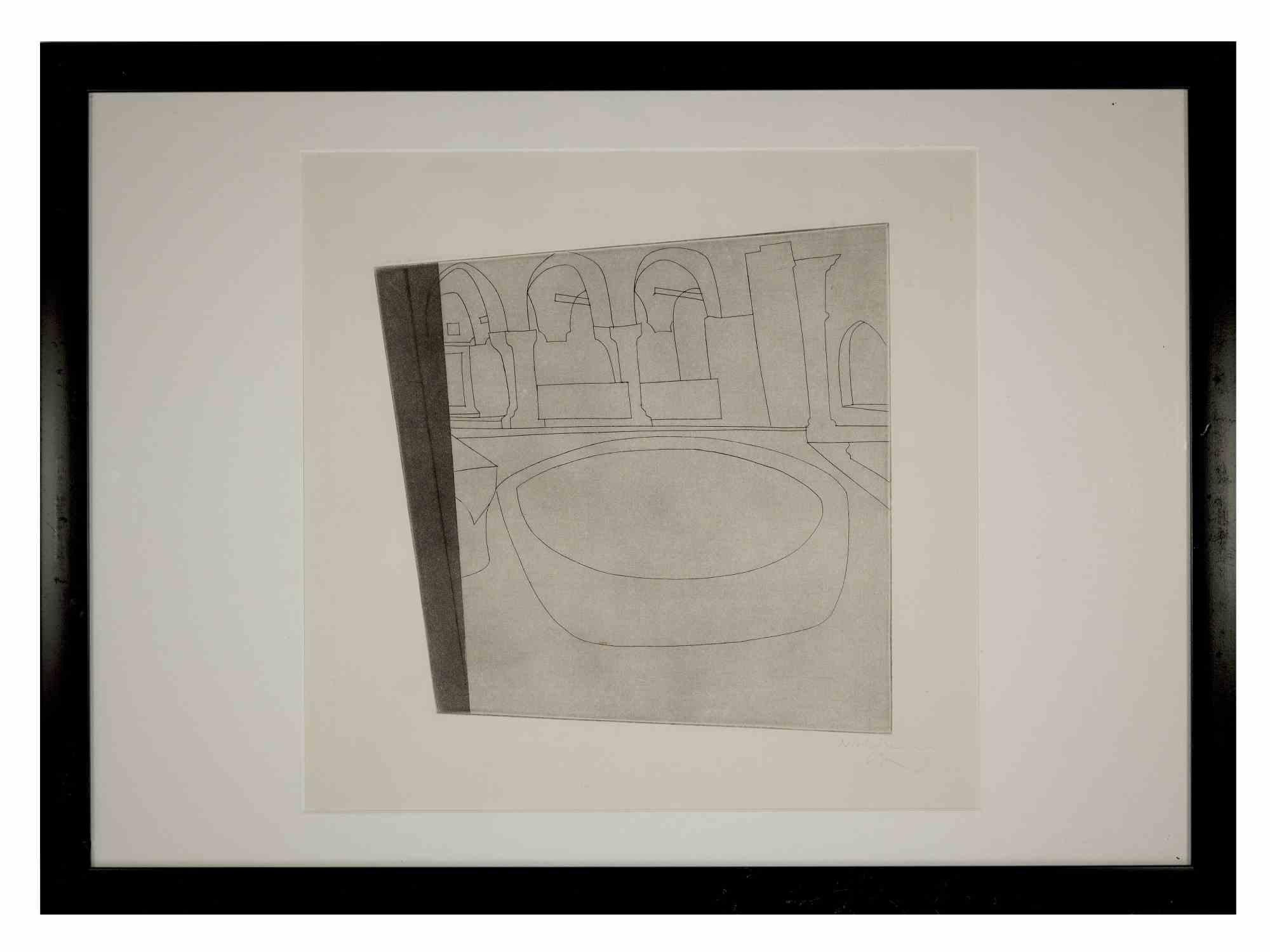
![Siena [Large Version] - British Modernism Italian Architecture Siena](https://a.1stdibscdn.com/ben-nicholson-prints-works-on-paper-siena-large-version-british-modernism-italian-architecture-siena-for-sale/a_180/1748704394244/11625_01_master.jpg)
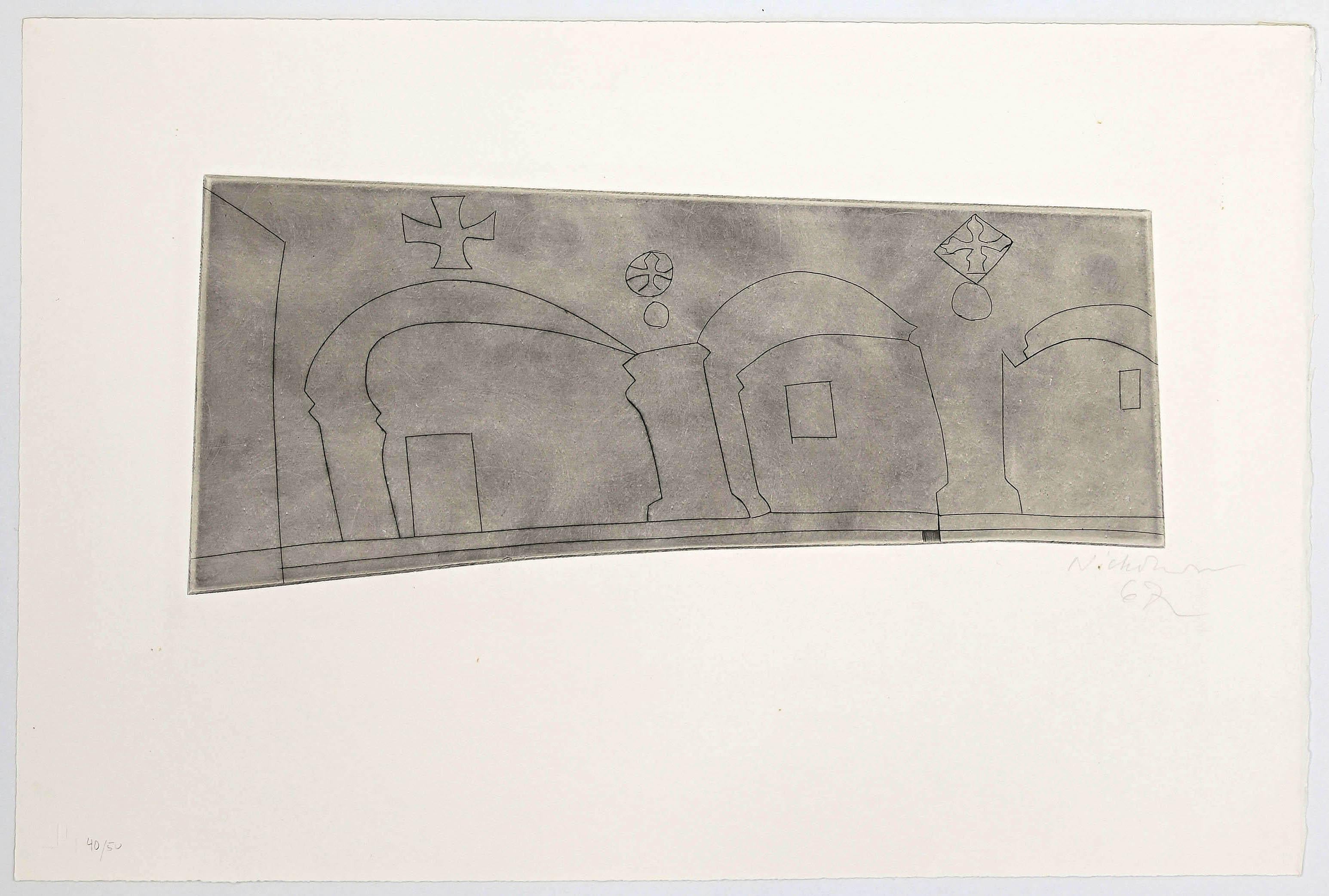
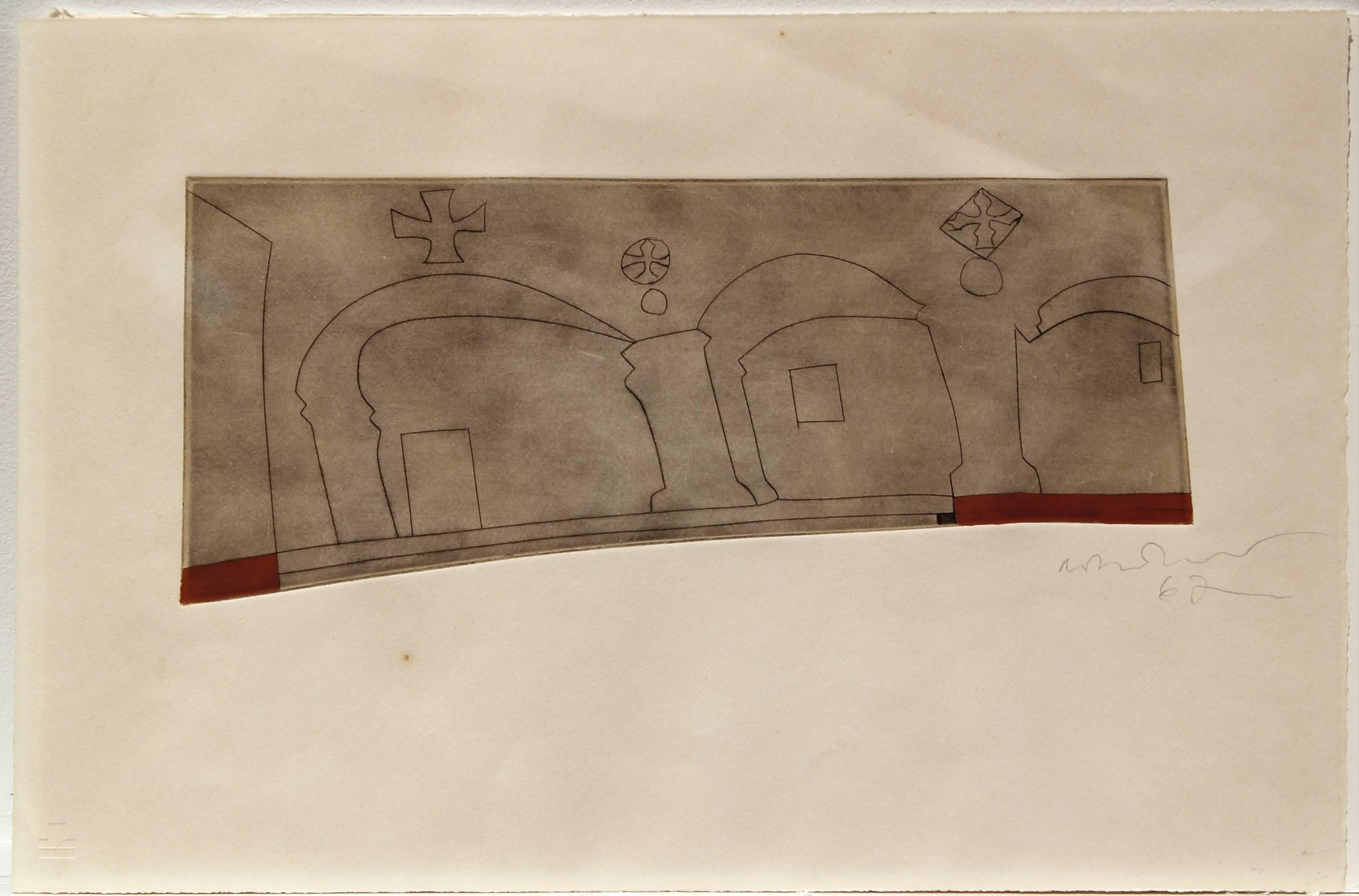
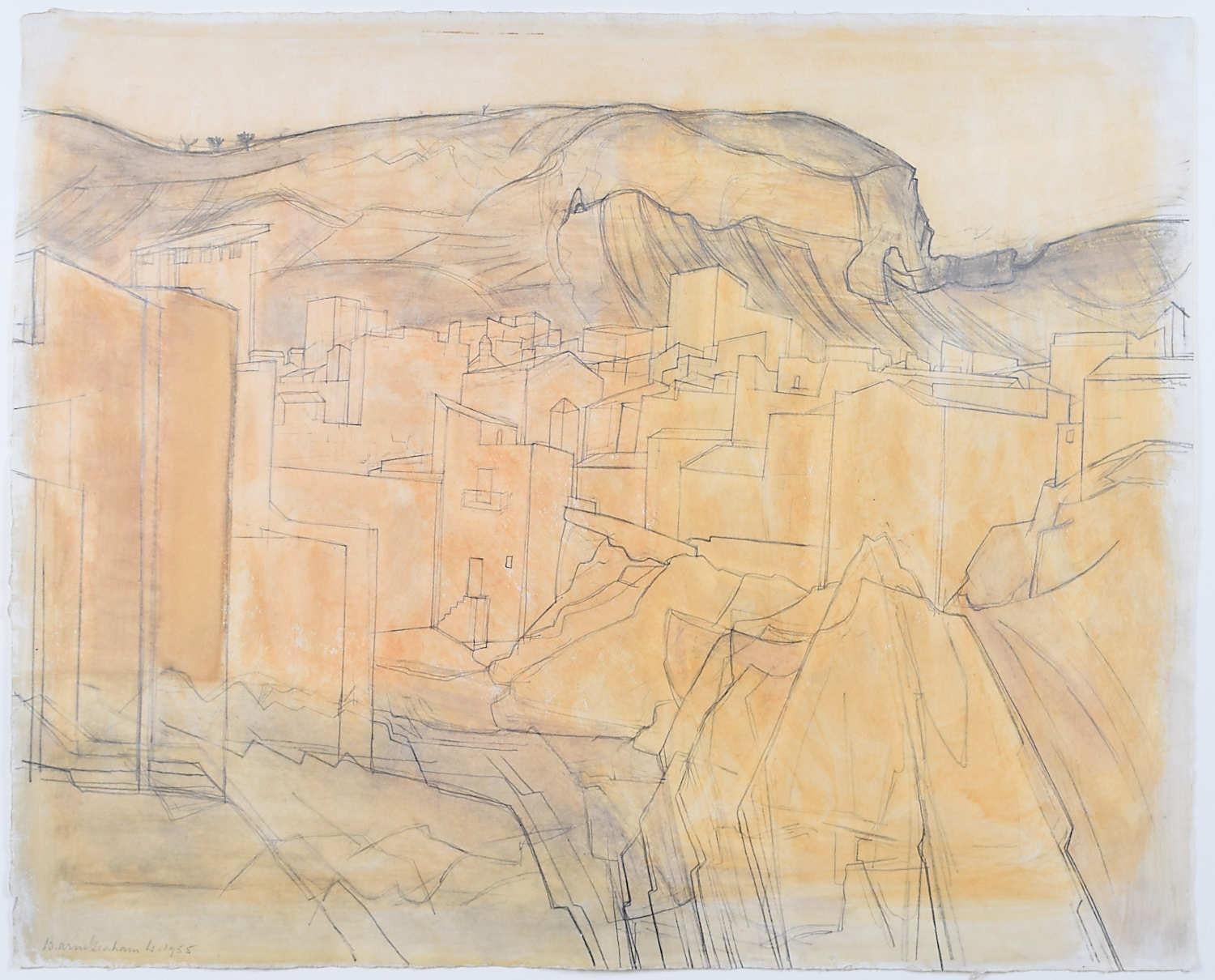
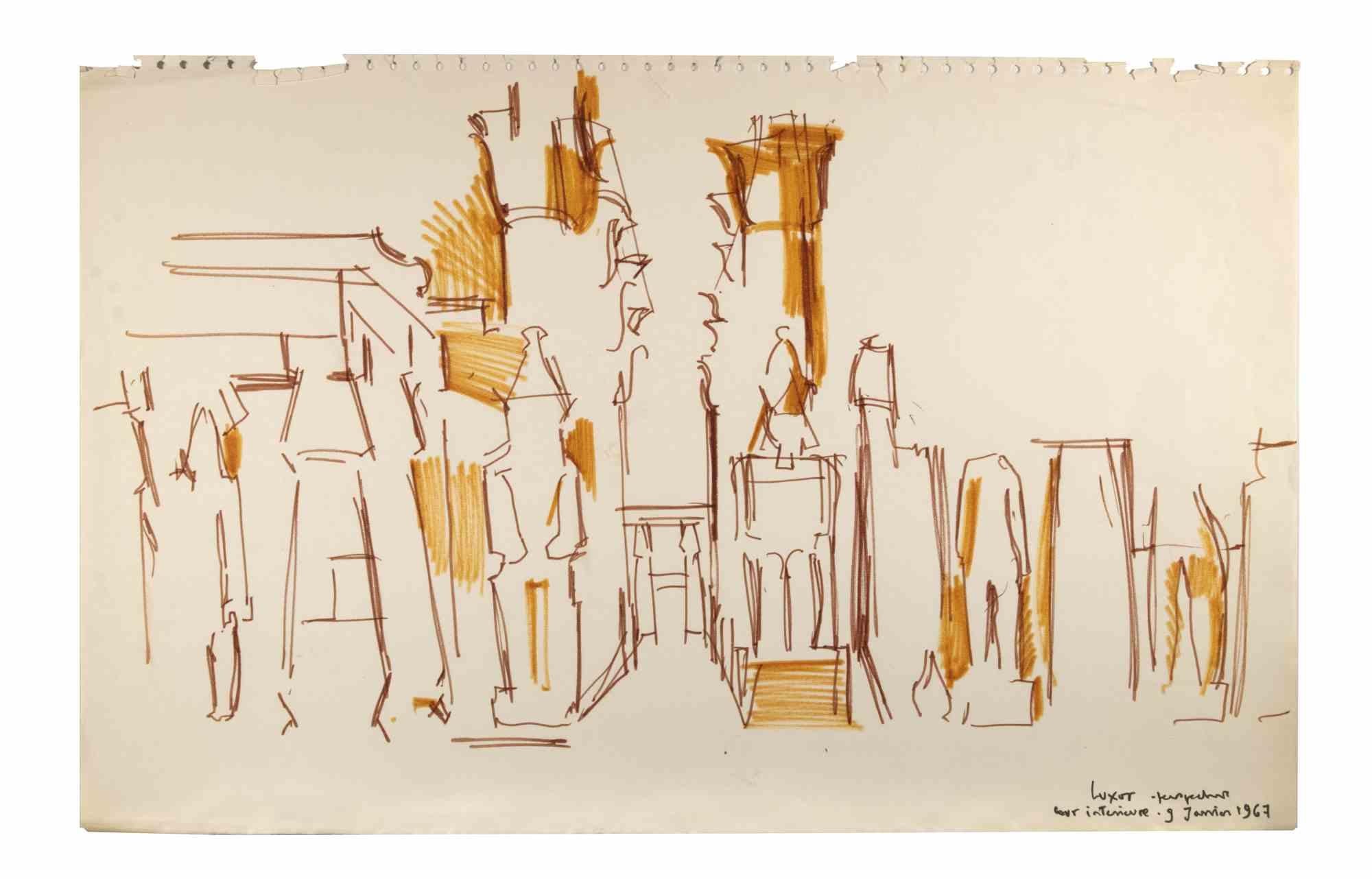
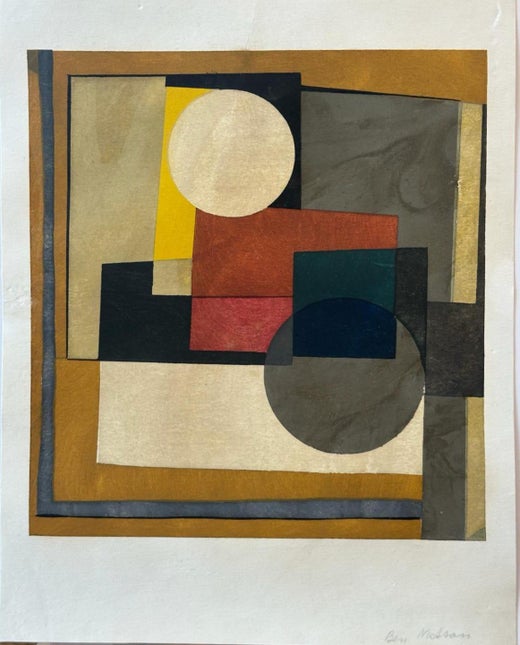
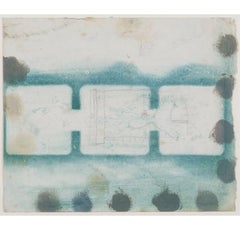

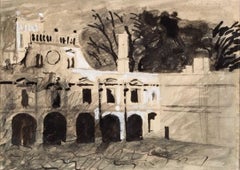
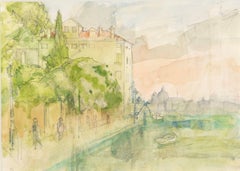
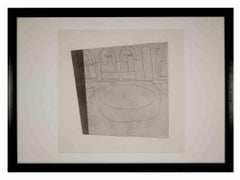
![Siena [Large Version] - British Modernism Italian Architecture Siena](https://a.1stdibscdn.com/ben-nicholson-prints-works-on-paper-siena-large-version-british-modernism-italian-architecture-siena-for-sale/a_180/1748704394244/11625_01_master.jpg?width=240)
